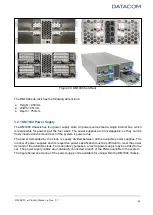
DM-
SV01 ● Product Manual ● Rev. 1.1
56
Supported DIMM types:
● 1R and 2R RDIMM, built with x4 and x8 DDR4 devices.
● 4R and 8R LRDIMM, built with x4 DDR4 devices (4DR, 2S2R, 2S4R devices).
● 2S2R (= 4R) and 2S4R (= 8R) 3DS built with x4 DDR4 devices.
Each processor has eight memory channels, which are designated A, B, C, D, E, F, G, and H. The
figure below depicts the physical memory channels distribution in the motherboard.
Figure 59: DIMMs location
The following DIMM population guidelines must be followed as per AMD recommendation, in
order to guarantee the best performance results from the CPUs:
● Each CPU should have all the eight DIMM slots (A, B, C, D, E, F, G and H) populated.
● All DDR4 modules must have the same capacity.
If it is not possible to populate all the eight slots per processor, the user has still the following option:
● If the processors have up to 32 cores each, the user may install four DIMM modules on slots C,
D, G and H. The server performance may be reduced when compared to the recommended full
DIMM population condition.
Other DIMM configurations are not allowed, once they result in considerable loss of performance.
5.2.2 DIMMs installation procedure
CAUTION:
care should be taken when inserting or removing DIMM modules to prevent any damage.
Please refer to section “3.1 ESD Precautions” for details regarding the safe handling of DM-SV01 sub-
modules.
The insertion of DIMM modules must be done by following the procedure below.
1. Holding the DDR4 module by its edges, position the module over the DIMM slot. In order to
know the correct orientation of the module, refer to the central chamfer of the DDR4 module: it
should be aligned with the plastic partition of the DIMM slot, as shown in the figure below.
















































